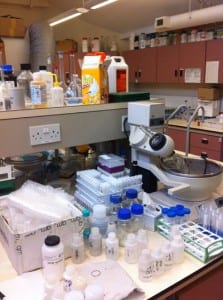Science + Art = ?
By Nick J Booth, on 6 May 2014
What happens when you give a Geology Museum to a set of Art Students? Well we are about to find out…
Last year a group of sculpture Masters students from the Slade School of Fine Art took over the Rock Room (UCL’s Geology Museum) for a day, created a load of new art works relating to the space and the collection, and then opened it up to the public to view their work. It was a great day, we had a lot of visitors and the students seemed to enjoy themselves.
This year I met with the Slade organiser, Lecturer in Sculpture Karin Ruggaber, early, and we decided that we would build on the work of last time, by offering a tour of some of the lesser seen parts of the Geology Collections, and the Earth Science Department here at UCL,
as well as giving them the opportunity to do with the Rock Room as they will. Earth Science as a subject is concerned with the physical make up of the Earth (and other planets), and the Geology Collections are part of the department, so this seemed like a good fit.
The tour took place last Friday (May 2nd) and involved two groups of Slade students, about 24 in total, as well as myself, Ruth Siddall and Wendy Kirk from the department (REAL Geologists, I’m just an archaeologist by training) and Karin. The Earth Science staff were great, and gave their time generously and freely. I know how busy they are so I want to take this opportunity to say thank you to them all.
Tours were given in the Rock Room, a Geo-Chemistry Lab, the Art Museum, the Regional Planetary Image Facility, and several labs that form part of the Earth Science department. Of these labs all of them were excellent, however the Ice Physics Laboratory was probably one of the most popular. This involved the group walking into a freezer complex, with rooms ranging in temperature from -20 Celsius, to a balmy -2 or so.
Taking in the other labs the tour also afforded the opportunity to view a rock broken down into a liquid, a machine that replicates the processes of a volcano, a set of machines designed to be placed in the sea to exert pressure on rock samples and a gold plated ant. There really is some amazing stuff going on in the Earth Sciences Labs at UCL.
The students will be taking over the Rock Room this Friday (9th May), and their work will be open to view between 1 – 5. The event is going to be called dəprɛʃ dəprɛst. I have no idea what they are going to bring with them, or how they will react to the Rock Room space. However I did field questions during the day about fish getting baked into rock salt (could be smelly), what acid to use on a pear (I have no idea) and what type of mineral is best to develop a photo through (again, not a clue).
I am looking forward to it, and I urge you to come by and have a look if you can.
It’s going to be interesting!
Nick Booth is a Teaching & Research Curator at UCL. He helps to look after the Science and Engineering Collections.
3 Responses to “Science + Art = ?”
- 1
-
2
Rock Room Slade School Takeover – Part 3 | UCL UCL Museums & Collections Blog wrote on 5 May 2015:

[…] of the joint UCL Museums and Slade School of Fine Art project (see a blog on the last one here) which has seen staff and students from the Slade install art works that include sculpture, […]
-
3
The Slade Rock Room Takeover – ‘Poison’ | UCL Museums & Collections Blog wrote on 5 May 2016:

[…] one day pop-up event has been totally different from the last, you can read about previous events here and here. This year marks the fourth instalment of the project, and the last in the Rock […]
 Close
Close







[…] Karen Ruggaber, as she leads a discussion on a project we recently worked on which saw a group of Slade Students take over the Rock Room for a day. Beforehand they were given a tour of behind–the-scenes in the Earth Science […]